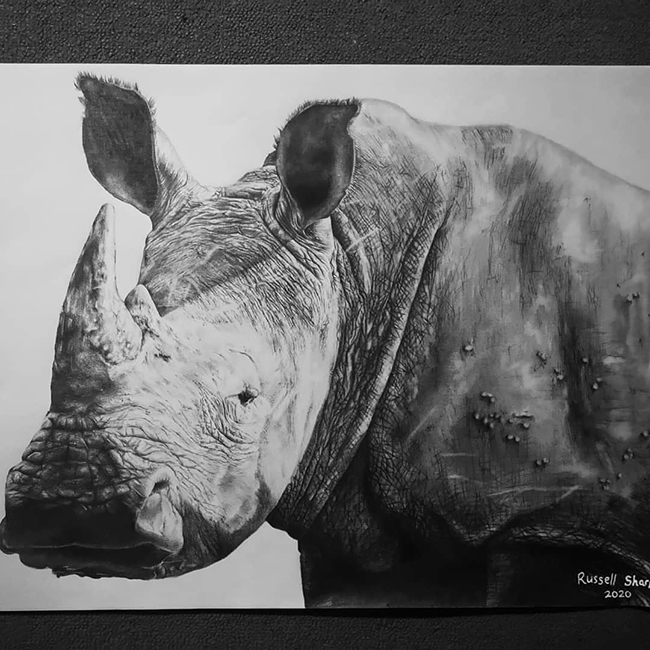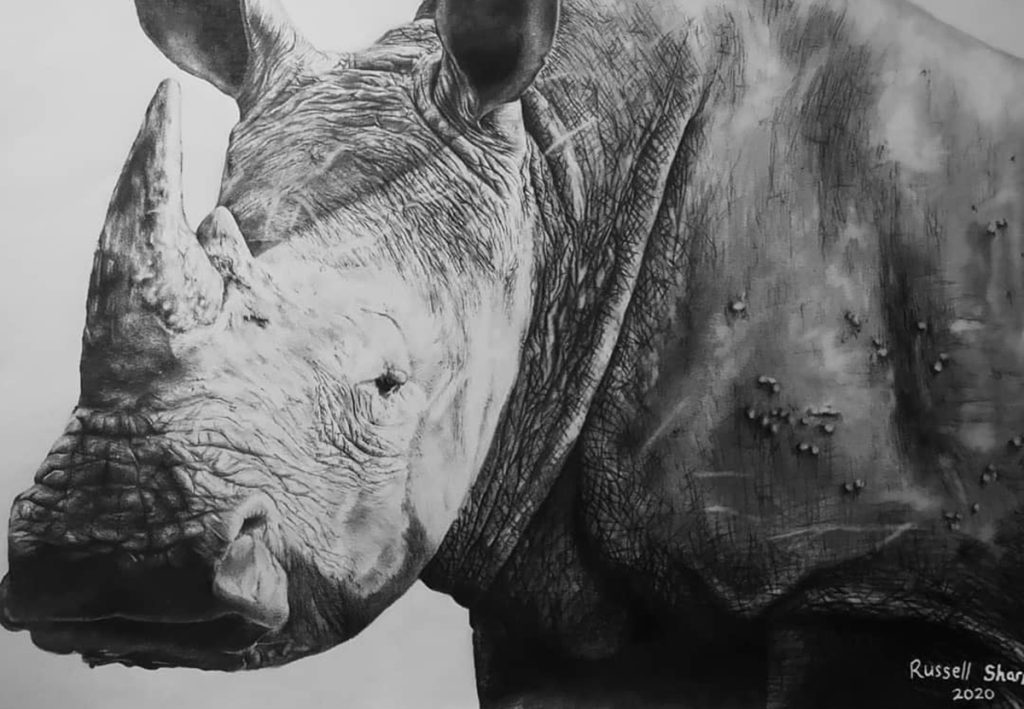Russell Sharp is a South African visual artist and educator whose work lives at the crossroads of technical mastery and emotional depth. His pencil drawings are rich in detail, capturing wildlife, identity, and everyday forms with the kind of patience that only comes from years of disciplined practice. Sharp has built his life around both art and education. As the Director of Arts, Drama, and Chess at St Catherine’s School, he cultivates creativity in younger generations, encouraging them to approach art with both integrity and curiosity. Beyond the school walls, he serves as Visual Arts Subject Advisor and Lead Educator for the King Cetshwayo District, shaping cultural growth and raising the standard of artistic excellence in his community.
Sharp’s dual role as artist and teacher gives his work a rare balance—rooted in discipline, yet alive with empathy. His rhinoceros drawing exemplifies this commitment, both to craft and to meaning.

The Rhinoceros Drawing
At the heart of Russell Sharp’s practice lies an unflinching commitment to detail. This is most clearly seen in his pencil drawing of a rhinoceros. The subject, massive and commanding, is rendered with tonal depth that brings both weight and fragility to the surface of the paper. Sharp’s treatment of the animal goes beyond illustration. Each line is deliberate, serving not just to outline but to reveal, giving the impression that the rhinoceros emerges from the page with quiet strength.
The work invites the viewer to pause. To look closely at the folds of skin, the weathered hide, and the textured horn is to encounter the slow passage of time. Sharp’s shading captures not only the bulk of the animal but also the sense of a being marked by survival. The drawing becomes more than a portrait; it becomes a meditation on resilience.
Yet, alongside this resilience sits fragility. The rhinoceros, though thick-skinned and seemingly indestructible, is an endangered creature. Sharp’s drawing doesn’t shy away from this paradox. The precision in his lines underscores the reality that the very details we admire—its horn, its strength, its sheer presence—are what make the rhinoceros vulnerable to human exploitation. By embedding reverence within technique, Sharp creates a tension between beauty and threat, majesty and extinction.
Honoring Wildlife Through Art
Sharp’s fascination with detail isn’t only about skill—it’s about respect. The rhinoceros drawing reflects his larger philosophy: that to draw something carefully is to honor its existence. He doesn’t romanticize the animal into abstraction, nor does he reduce it to a symbol. Instead, he allows the rhinoceros to remain itself, with all its imperfections and grandeur intact.
In doing so, he asks us to see the animal differently. To consider not just its size but its vulnerability. The quiet pencil marks act as a call to awareness. They remind us that wildlife is more than a subject for art—it is a living presence whose survival is intertwined with our responsibility.
This approach mirrors Sharp’s role as an educator. Just as he teaches his students to look deeper and notice subtleties in their own creative work, he models the same attentiveness in his drawings. The rhinoceros becomes a lesson in both technique and empathy.
The Language of Detail
What makes Sharp’s rhinoceros drawing compelling is the way it balances technical discipline with emotional resonance. Many artists can render an animal with accuracy. Few can imbue that accuracy with feeling. Sharp’s tonal contrasts, the shifting from light to dark, suggest more than volume. They suggest mood. The drawing has an atmosphere that feels both calm and urgent, steady yet threatened.
The technical side—line weight, cross-hatching, tonal layering—serves as the structure. But what gives the drawing its force is Sharp’s decision to let reverence guide his hand. Each contour of the rhino’s skin becomes an act of recognition. Each shadow becomes a reminder that light itself is fleeting.
Resilience and Fragility
Ultimately, the rhinoceros drawing stands as both tribute and warning. It honors the majesty of a creature that has roamed the earth for millions of years. At the same time, it gestures toward the precariousness of that existence in today’s world. The drawing holds these contradictions in tension, allowing viewers to feel the weight of both.
Sharp doesn’t tell us what to think. He offers the rhino as it is, rendered with care and presence, and trusts that the drawing itself will stir reflection. In this way, his work fulfills its purpose: to make us see more clearly, to feel more deeply, and to recognize the fragility within strength.
Conclusion
Russell Sharp’s rhinoceros drawing is more than a technical exercise. It is a meditation on presence, survival, and the delicate balance of nature. His skill with pencil allows him to capture the finest details, but it is his reverence for the subject that transforms those details into meaning.
As both artist and educator, Sharp embodies a practice of attentiveness—teaching others to observe carefully while modeling that same discipline in his own art. His rhinoceros is not just a drawing. It is a reminder: that beauty, resilience, and fragility often live side by side, and that it is our responsibility to notice before it is too late.

